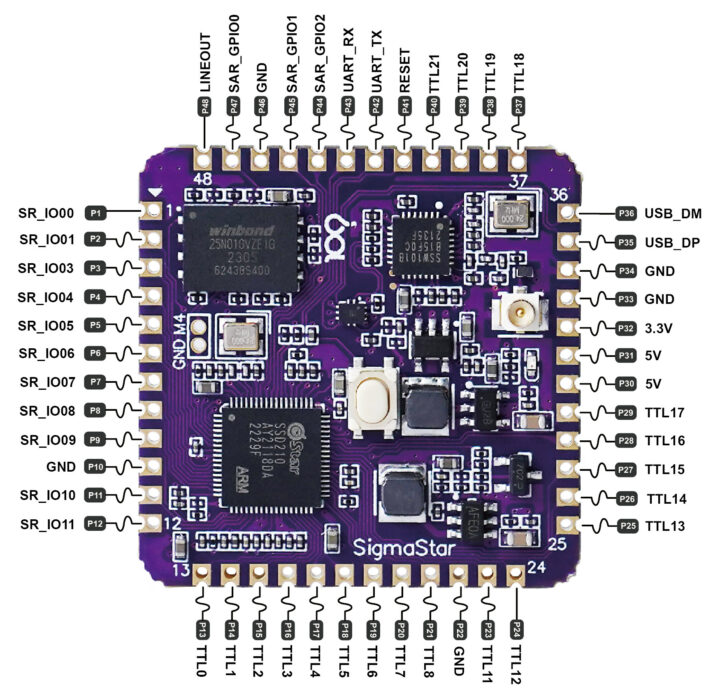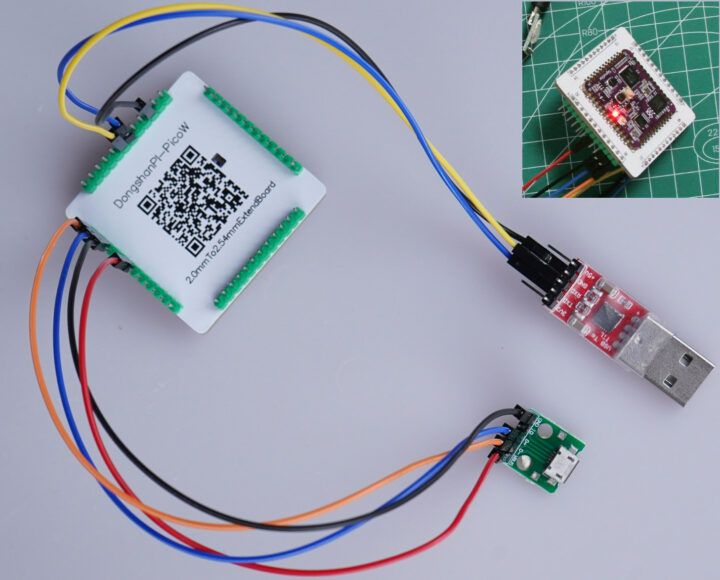Based on its name, the DongshanPI-PicoW board/module aims to be an Arm Linux alternative to the Raspberry Pi Pico W with a SigmaStar SSD210 dual-core Cortex-A7 processor with 64MB RAM, an SSW101B USB WiFi 4 chip, plus a good amount of I/Os thanks to four 12-pin headers.
The module also comes with a 128MB SPI flash to run Linux, takes 5V power input, and offers a display interface up to 1280×800, USB 2.0, audio interfaces, and more in a small 31×31 mm form factor with 48 through and castellated holes that should be easy to integrate into compact devices.
DongshanPI-PicoW specifications:
- SoC – SigmaStar SSD210 dual-core Arm Cortex-A7 at up to 1.0GHz with FPU, NEON, MMU, DMA, 2D graphics accelerator, 64MB on-chip DDR2 RAM
- Storage – 128MB SPI NAND flash (Winbond W25N010)
- Connectivity – Sigmastart SSW101B 802.11b/g/n 2.4GHz 1T1R WiFi 4 module + u.FL antenna connector
- USB switch – Onsemi FSUSB30 2-port switch
- Four 12-pin 2.0mm pitch headers with castellated holes
- Display
- Up to 2x MIPI interfaces with 2 or 1 data lane and 2 clock lanes
- TTL output up to 1280×800 60fps
- Audio – MIC and DMIC inputs, Line out, 8-channel I2S/TDM with 2/4/8-channel Rx, 2-channel Tx
- Networking – 1x 10/100M Ethernet
- USB – 1x USB 2.0
- Misc – 1x SDIO 2.0, 2x SPI, 2x I2C, 4x UART, 4x PWM, GPIOs
- Display
- Security Engines (AES/DES/3DES/RSA/SHA-I/SHA-256)
- Misc – Reset button
- Power Supply – 5V via I/O pins
- Dimensions – 31 x 31 mm (estimated)
The lack of a physical USB port makes the PicoW module great for integration into projects, but you’ll need some wiring for power and programming. The photo above shows the DongShanPi-PicoW soldered to a 2.0mm to 2.54mm pitch adapter with a micro USB board connected for power and flashing the firmware, and a USB to TTL debug connected to UART to access the serial console.
You’ll find some documents in Chinese as well as the schematics and a Linux image and flashing tools in the Wiki. Questions can be asked on Twitter or in a forum. SigmaStar SSD2xx processors have some support in Linux mainline, and additional information can be found on the Linux Chenxing website. I suppose the module could also replace the Raspberry Pi Zero W for some lightweight applications that may not need 512MB of RAM or an HDMI display. Connecting a MIPI display is possible, but you’d need to find a display that works with the module.
The DongshanPI-PicoW is sold on Aliexpress for $6.71 plus shipping (around $10 in total), but without the 2.54mm pitch adapter board, so you’d need to do some light soldering to wire the board for power and the serial console.

Jean-Luc started CNX Software in 2010 as a part-time endeavor, before quitting his job as a software engineering manager, and starting to write daily news, and reviews full time later in 2011.
Support CNX Software! Donate via cryptocurrencies, become a Patron on Patreon, or purchase goods on Amazon or Aliexpress






